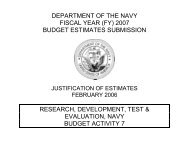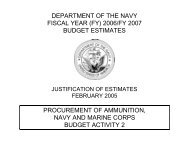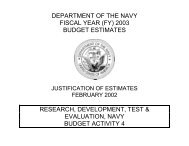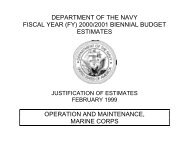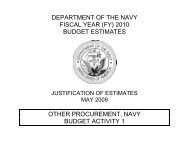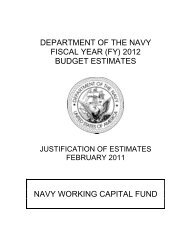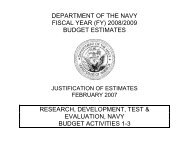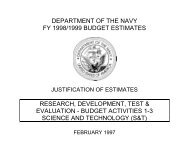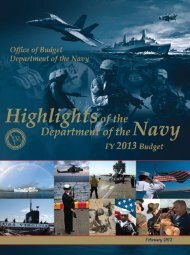Other Procurement, BA 4 - U.S. Navy
Other Procurement, BA 4 - U.S. Navy
Other Procurement, BA 4 - U.S. Navy
You also want an ePaper? Increase the reach of your titles
YUMPU automatically turns print PDFs into web optimized ePapers that Google loves.
CLASSIFICATION:UNCLASSIFIEDBUDGET ITEM JUSTIFICATION SHEETDATE:P-40 February 2005APPROPRIATION/BUDGET ACTIVITYP-1 ITEM NOMENCLATUREOTHER PROCUREMENT, NAVY/<strong>BA</strong>4 SHIP SELF DEFENSE SYSTEM (SSDS) / 5239Program Element for Code B Items:<strong>Other</strong> Related Program ElementsP.E. 0604755N / 0603582N / 0604307NFY2003 ID ToAnd Prior Code FY 2004 FY 2005 FY 2006 FY 2007 FY 2008 FY 2009 FY 2010 FY 2011 Complete TotalQUANTITY 19 A/B 3 1 5 5 4 5 3 3 8 56COST(In Millions) $220.7 A/B $57.3 $41.9 $33.4 $57.3 $48.0 $72.0 $55.3 $81.1 $298.2 $965.1SPARES COST(In Millions)SHIP SELF DEFENSE SYSTEM (SSDS) MK 0, RAPID ANTI-AIR SHIP MISSILE INTEGRATED DEFENSE SYSTEM (RAIDS), is on board DD 963/FFG 7 class ships and provides decision support toweapons systems operators and managers.SSDS MK 1 provides ship self defense capabilities against Anti-Ship Cruise Missiles (ASCM) for LSD 41/49 class ships. It integrates several existing stand-alone sensor and Anti-Air Warfare (AAW)weapons systems to provide an automated detect-to-engage capability against low flying, high speed ASCMs with low radar cross sections in the littoral environment. System design emphasizesphysically distributed non-developmental items, commercial standards, Next Generation Computer Resources, and computer program reuse in an open architecture computer network. It includes acommand table that uses components of the <strong>Navy</strong>’s AN/UYQ-70 standard display for human-machine interface, commercially available local area network access units and circuit cards, andcommercially available fiber optic cabling. SSDS MK 1 requires a COTS obsolescence effort and transition to Open Architecture (OA) Category 3 beginning in FY07, thus providing the LSD class shipswith a compatible equipment suite to host the OA track manager and other OA functions.SSDS MK 2 provides Advance Combat Direction System (ACDS) functionality and SSDS MK1 capabilities with additional weapon and sensor elements. It is integrated with Cooperative EngagementCapability (CEC) to improve joint interoperability for Aircraft Carriers and Amphibious Ships. It provides enhanced capabilities for Force Protection against air, surface, and subsurface threats using bothown-ship and remote data in support of the AAW Capstone Requirements. SSDS MK2 increases operational capabilities, improves combat readiness and Battle Group interoperability, and promotesstandardization both within installed ship classes and with AEGIS to facilitate transition to Common Command and Decision. SSDS MK 2 also equips all backfit LHDs and CV(N)s with an upgradedCombat System Display Suite which includes AN/UYQ-70 consoles, Automatic Status Boards (ASTABS), Remote ASTAB Controllers and Advanced Sensor Distribution System (ASDS). A shore basedSSDS MK 2 equipment suite and a full combat system suite is installed at the Ship Combat System Center (SCSC). In FY03/FY04 procurement funded the CVN 68, LHD 7, Self Defense Test Ship(SDTS), CV 67, and CVN 74 ships, of which three are ACDS Block 1 Ships and require immediate replacement. FY05 procures the CVN 75. FY06-FY08 conducts Commercial Off The Shelf (COTS)obsolescence sustainment to previously installed baselines and FY09/FY10/FY11 procures the CVN 65/72/73, reducing the number of adequated systems deployed on carriers.Common Network Interface (CNI). As the <strong>Navy</strong> embarks on <strong>Navy</strong> Open Architecture (NOA), CNI has been selected for Combat Direction System (CDS) upgrade on the LHA/LHD ship class.Engineering efforts initiated via direction from OSD in FY04/05. The program's development is to complete in CY05 with a land based demonstration scheduled in March 2005 and an at-seademonstration scheduled for September 06. Production commences in FY07 with installation planned in FY08 for the LHA and LHD Class ships. Future software and hardware modifications are plannedfor FY07 and out. CNI is a COTS open interface system transitioning to an upgrade that modernizes Combat Systems on legacy amphibious ships, LHA/LHD classes, which will support theExpeditionary Strike Group (ESG). CNI upgrades the existing system using COTS hardware and common interoperable software compliant with the <strong>Navy</strong>’s Open Architecture standards to integrate thedata from ship’s sensors, external links, and FORCEnet sources into an operational picture for the war fighter and an out put to the legacy ACDS weapons control system. CNI provides rapid operationalcapability upgrades via an Advanced Processing Build (APB) process using primarily software upgrades, an integrated Air, Surface, ISR, and friendly shore position and situational awareness trackpicture. CNI will allow for the implementation of the Joint Track Manager via the OA Track Manager (OATM) and FORCEnet and Network centric connectivity.Amphibious Assault Direction System (AADS) or AN/KSQ-1 integrates the Position Location Reporting System (PLRS) or Enhanced PLRS (EPLRS) systems with NAVSTAR Global PositioningSystem (GPS) via a Global Positioning System Interface Unit (GPSIU) to form a jam/intercept resistant, command and control system which supports the surface assault ship-to-shore movement inamphibious operations. An airborne relay group extends the system range over the horizon to 100 nautical miles. By computing Position Location Information (PLI) for each participant in the PLR / EPLRSnet, AADS provides the capability, in near real-time to locate, identify, track, communicate with and control all craft, vehicles and personnel in the net during operations afloat and ashore.Combat Direction System (CDS) COTS Obsolescence is funded throughout the FYDP. In addition to SSDS, this effort includes Advance Combat Direction Systems (ACDS) as they evolve andmigrate to <strong>Navy</strong> Open Architecture (NOA). These variants will be required to maintain COTS as parts become obsolete or replacements are needed to comply with NOA standards and future NOAsoftware libraries.This P-1 line item supports a multitude of Commericial Off The Shelf (COTS) based systems used within the combat system.P-1 SHOPPING LIST 105 CLASSIFICATION:DD Form 2454, JUN 86 PAGE NO. 1UNCLASSIFIED



